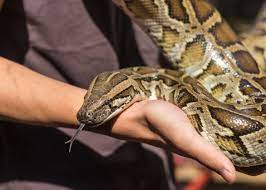Have you ever wondered, “How fast do Burmese pythons grow?” It’s a question that leads us down a fascinating path into the growth patterns and incredible development of one of the largest snake species on Earth.
Burmese pythons are known for their impressive growth rate, especially during their first few years of life. In ideal conditions, young Burmese pythons can grow at an astonishing rate of up to one foot (30 centimeters) per month for the first few years.
However, their growth rate tends to slow down as they reach maturity. Adult Burmese pythons can still grow, but at a much slower pace, typically adding a few inches (several centimeters) to their length each year. The exact growth rate can vary depending on factors such as food availability, environmental conditions, and individual genetics.
How fast do burmese pythons grow?

Burmese pythons are known for their relatively rapid growth rate, especially during their early years. Typically, they can grow at a rate of about 1 to 2 feet per year during their first few years of life. However, growth rates can vary depending on factors such as food availability, environmental conditions, and individual genetics.
In ideal conditions with plentiful food and proper care, they can reach lengths of over 10 feet within a few years. However, their growth tends to slow down as they reach adulthood, and they may only grow a few inches per year once they reach maturity.
Growth Stages of Burmese Pythons
Burmese pythons, like many snakes, go through several distinct growth stages as they mature:
- Hatchling Stage: When Burmese pythons hatch from their eggs, they are typically around 18 to 24 inches in length. At this stage, they are entirely dependent on their yolk sac reserves for nutrition, and they are vulnerable to predation.
- Juvenile Stage: During the juvenile stage, which lasts for the first few years of life, Burmese pythons experience rapid growth. They can grow at a rate of 1 to 2 feet per year during this stage, depending on factors such as food availability and environmental conditions. Juvenile pythons are active hunters, feeding on small mammals, birds, and reptiles.
- Subadult Stage: As Burmese pythons reach sexual maturity, they enter the subadult stage. This typically occurs around 3 to 5 years of age, depending on various factors. Subadult pythons are larger than juveniles but have not yet reached their full adult size. They continue to grow, albeit at a slower rate compared to juveniles.
- Adult Stage: Once Burmese pythons reach full adulthood, they have reached their maximum size. Adult females tend to be larger than males, with some individuals reaching lengths of over 15 feet or more. At this stage, their growth rate slows down significantly, and they may only grow a few inches per year, mainly to replace old skin during shedding.
Understanding these growth stages is essential for properly caring for Burmese pythons in captivity, as their dietary and environmental needs can vary depending on their age and size.
Factors Influencing Burmese Pythons Growth Rate
Several factors can influence the growth rate of Burmese pythons:
- Feeding: Adequate nutrition is crucial for healthy growth in Burmese pythons. A diet consisting of appropriately sized prey items, such as rodents, rabbits, or poultry, is necessary to support growth. Regular feeding schedules and ensuring that the prey items are nutritionally balanced can promote optimal growth.
- Temperature and Environment: Burmese pythons are ectothermic, meaning their body temperature is regulated by their environment. Maintaining appropriate temperatures within their enclosure, including a basking spot for thermoregulation, is essential for metabolic function and growth. Consistent environmental conditions, including humidity levels, also play a role in promoting healthy growth.
- Genetics: Genetic factors can influence the growth potential of Burmese pythons. Some individuals may have genes that predispose them to larger or faster growth, while others may grow more slowly. Breeding from healthy, robust individuals can help ensure desirable growth traits in offspring.
- Sex and Age: Female Burmese pythons tend to grow larger than males, with adult females often reaching lengths of over 15 feet. Additionally, growth rates vary throughout different life stages, with juveniles experiencing rapid growth compared to subadults and adults.
- Health and Wellness: Health issues such as parasites, infections, or metabolic disorders can negatively impact growth in Burmese pythons. Regular veterinary check-ups, proper hygiene, and monitoring for signs of illness are important for maintaining optimal growth rates.
- Enclosure Size: Providing a spacious and appropriately sized enclosure allows Burmese pythons to move and stretch, which can contribute to healthy growth. Enclosures should offer enough room for exercise and exploration without being overly large, as excessively large enclosures can make it challenging for snakes to find their prey and regulate their body temperature.
By considering and addressing these factors, snake owners can help ensure that their Burmese pythons grow healthily and reach their full potential size.
Growth Rate Comparison with Other Python Species

When comparing the growth rates of Burmese pythons to other python species, several factors come into play, including genetics, environment, and available resources. Here’s a general overview:
- Burmese Python (Python bivittatus): As previously mentioned, Burmese pythons are known for their relatively rapid growth, especially during their juvenile stage. They can grow at a rate of about 1 to 2 feet per year during their early years, with some individuals reaching lengths of over 10 feet within a few years under ideal conditions.
- Ball Python (Python regius): Ball pythons are generally slower-growing compared to Burmese pythons. While they may start off growing quickly as hatchlings, their growth rate tends to slow down significantly as they age. Ball pythons typically reach sexual maturity at around 2 to 3 years of age, but they may continue to grow slowly throughout their lives, adding only a few inches per year.
- Reticulated Python (Malayopython reticulatus): Reticulated pythons are among the largest snake species in the world and can grow to be longer than Burmese pythons. They have the potential to grow more quickly than Burmese pythons, especially during their juvenile stage, but growth rates can vary widely depending on factors such as food availability and environmental conditions. Reticulated pythons can reach lengths of over 20 feet in captivity.
- African Rock Python (Python sebae): African rock pythons are another large python species, known for their robust build and aggressive temperament. Like reticulated pythons, they have the potential to grow quickly, especially during their early years. However, growth rates can vary among individuals, and some African rock pythons may grow more slowly than others.
Overall, while Burmese pythons are known for their relatively rapid growth compared to some other python species, growth rates can vary widely among individuals within each species. Factors such as genetics, environment, and care can all influence the growth rate of pythons in captivity.
Factors contributing to differences in growth rates
Several factors contribute to differences in growth rates among python species:
- Genetics: Genetic factors play a significant role in determining the growth potential of individual snakes within a species. Variations in genetics can result in differences in growth rates, size, and other physical characteristics.
- Feeding Habits and Diet: The availability of food and the type of diet can greatly influence growth rates. Species with access to abundant and nutritionally rich prey items may grow more quickly than those with limited food sources.
- Metabolic Rate: Each species has its own metabolic rate, which affects how efficiently they utilize nutrients from food for growth and energy. Species with higher metabolic rates may grow more quickly than those with lower metabolic rates.
- Environmental Conditions: Environmental factors such as temperature, humidity, and habitat type can impact growth rates. Snakes in environments with optimal conditions for growth may grow faster than those in less favorable environments.
- Sexual Dimorphism: Differences in growth rates between males and females, known as sexual dimorphism, can exist within species. In some python species, females grow larger and at a faster rate than males.
- Life History Traits: Life history traits, such as age at sexual maturity and reproductive strategy, can influence growth rates. Species with earlier sexual maturity and higher reproductive output may allocate more resources to reproduction rather than growth.
- Captivity vs. Wild: Growth rates may differ between snakes raised in captivity and those in the wild. Captive snakes often have access to consistent food sources and environmental conditions, which may result in faster growth rates compared to wild populations, where food availability can be variable.
By considering these factors, researchers and snake enthusiasts can better understand the variations in growth rates observed among different python species.

Importance of Monitoring burmese pythons Growth
Monitoring the growth of Burmese pythons is essential for several reasons:
- Health Assessment: Monitoring growth allows owners to track the overall health and well-being of their snakes. Abnormal growth patterns, such as sudden slowdowns or rapid spurts, could indicate underlying health issues that require attention.
- Nutritional Needs: By tracking growth, owners can ensure that their Burmese pythons are receiving adequate nutrition. Adjustments to feeding schedules or prey size may be necessary as snakes grow to support their changing metabolic demands.
- Preventing Obesity or Malnutrition: Overfeeding can lead to obesity and related health problems, while underfeeding can result in malnutrition and stunted growth. Monitoring growth helps owners strike a balance and prevent these issues.
- Environmental Factors: Growth can be influenced by environmental factors such as temperature, humidity, and enclosure size. Monitoring growth allows owners to assess whether environmental conditions are optimal for their snakes’ development.
- Breeding Potential: For breeders, monitoring growth is crucial for assessing the reproductive readiness of their snakes. Female Burmese pythons need to reach a certain size and maturity before they can safely reproduce. Tracking growth helps breeders determine when their snakes are ready for breeding.
- Educational Purposes: Monitoring growth provides valuable insights into the natural history and biology of Burmese pythons. Researchers can use growth data to better understand factors that influence growth rates in captivity and the wild.
Overall, regular monitoring of growth is an important aspect of responsible snake ownership and captive breeding programs. It helps ensure the health, nutrition, and well-being of Burmese pythons while providing valuable data for research and conservation efforts.
Conclusion
How fast do Burmese pythons grow? Burmese pythons exhibit rapid growth during their juvenile stage, typically adding 1 to 2 feet in length per year under optimal conditions. Monitoring their growth is crucial for assessing health, nutrition, and environmental factors, ensuring their well-being in captivity. Understanding their growth rate is essential for responsible ownership, breeding programs, and conservation efforts.

